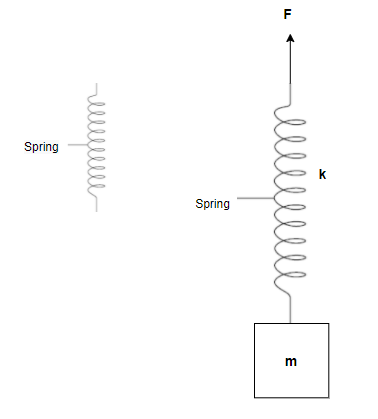
A block of mass m is connected to a spring (spring constant k). Initially the block is at rest and the spring is in its natural length. Now the system is released in gravitational field and a variable force F is applied on the upper end of the spring such that the downward acceleration of the block is given as a=g−αt, where t is time elapses and α=1m/s3, the velocity of the point of application of the force is

(A)
(B)
(C)
(D)

Answer
491.4k+ views
1 likes
Hint:-The given problem can be solved by taking the consideration of phenomena of a spring and a mass attached to it. When a mass is attached to it then there are forces working on the mass and this problem can be solved by taking the consideration of these masses.
Complete step-by-step solution:
Step 1: As it is given in the problem the force that is working on the upper end of the spring is variable force and the acceleration by which the block of mass m is moving downwards is
Let the original length of the spring at rest is
So, the elongation in length of the spring (let say
This
So,
Now considering the body, the force equation will be
Where
And
On solving the equation (1) and keeping the value from equation (2), we will get –
Step 2: To get the velocity, we can differentiate the equation (3), we will get –
But we know that from equation (1), we will get –
Where
Step 3: But we also know that –
And
On, integrating the above equation –
So from equation (4) and (5)
So,
So, the correct option is (A).
Note:- When the spring is compressed or elongated, it tends to recover its original length, on account of elasticity. The force trying to bring the spring back to its original configuration is called restoring force or spring force.
Complete step-by-step solution:
Step 1: As it is given in the problem the force that is working on the upper end of the spring is variable force and the acceleration by which the block of mass m is moving downwards is
Let the original length of the spring at rest is
So, the elongation in length of the spring (let say
This
So,
Now considering the body, the force equation will be
Where
And
On solving the equation (1) and keeping the value from equation (2), we will get –
Step 2: To get the velocity, we can differentiate the equation (3), we will get –
But we know that from equation (1), we will get –
Where
Step 3: But we also know that –
And
On, integrating the above equation –
So from equation (4) and (5)
So,
So, the correct option is (A).
Note:- When the spring is compressed or elongated, it tends to recover its original length, on account of elasticity. The force trying to bring the spring back to its original configuration is called restoring force or spring force.
Latest Vedantu courses for you
Grade 10 | CBSE | SCHOOL | English
Vedantu 10 CBSE Pro Course - (2025-26)
School Full course for CBSE students
₹37,300 per year
Recently Updated Pages
Master Class 9 General Knowledge: Engaging Questions & Answers for Success

Master Class 9 English: Engaging Questions & Answers for Success

Master Class 9 Science: Engaging Questions & Answers for Success

Master Class 9 Social Science: Engaging Questions & Answers for Success

Master Class 9 Maths: Engaging Questions & Answers for Success

Class 9 Question and Answer - Your Ultimate Solutions Guide

Trending doubts
Give 10 examples of unisexual and bisexual flowers

Draw a labelled sketch of the human eye class 12 physics CBSE

Differentiate between homogeneous and heterogeneous class 12 chemistry CBSE

Differentiate between insitu conservation and exsitu class 12 biology CBSE

What are the major means of transport Explain each class 12 social science CBSE

Why is the cell called the structural and functional class 12 biology CBSE




